The Sociology of Crime and Deviance
VerifiedAdded on 2023/04/24
|7
|2621
|170
AI Summary
This workbook highlights a need to understand how crime impacts upon the individual and society. It looks at various reasons why crime and deviance exist and how it is explained through sociological research.
Contribute Materials
Your contribution can guide someone’s learning journey. Share your
documents today.
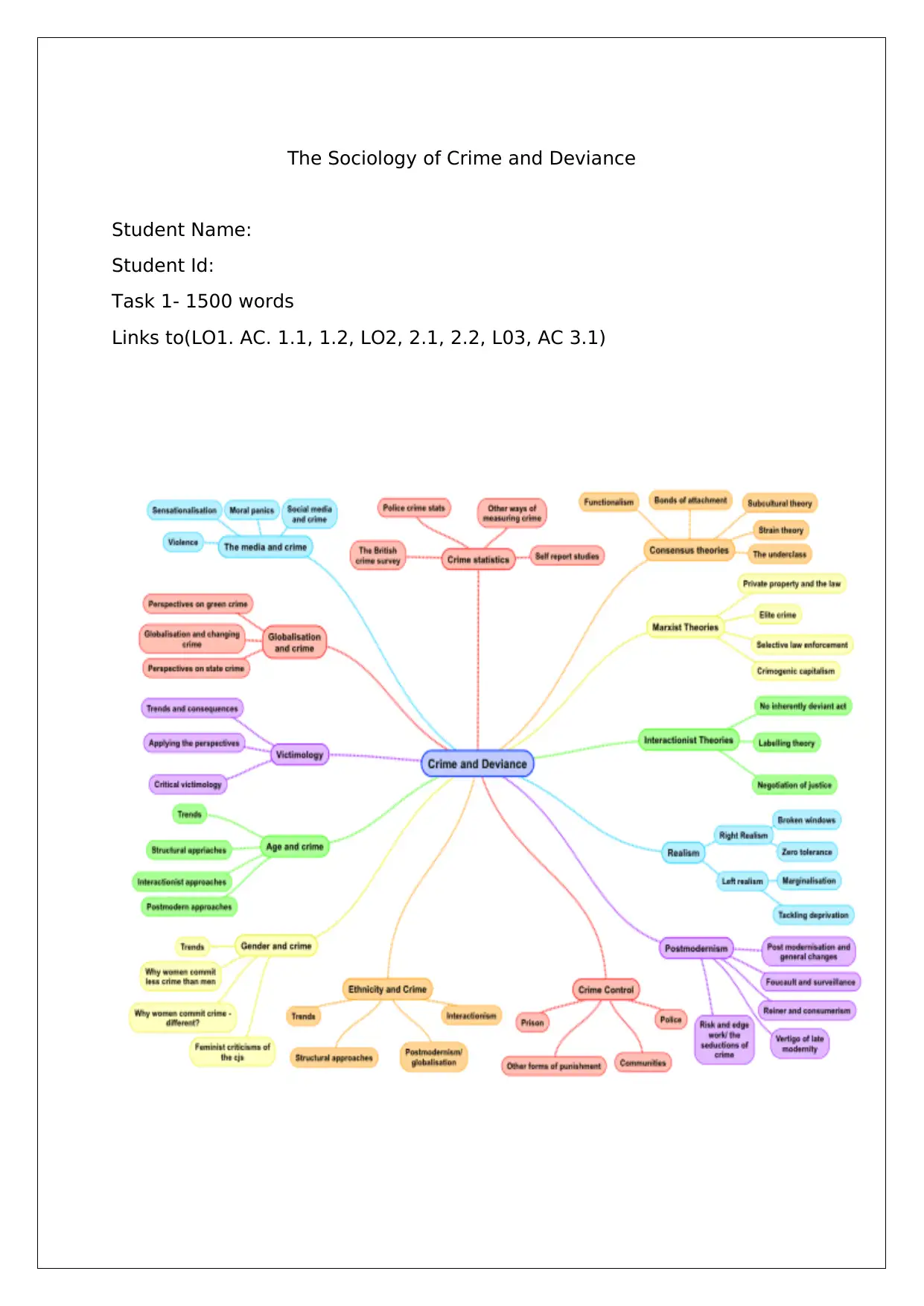
The Sociology of Crime and Deviance
Student Name:
Student Id:
Task 1- 1500 words
Links to(LO1. AC. 1.1, 1.2, LO2, 2.1, 2.2, L03, AC 3.1)
Student Name:
Student Id:
Task 1- 1500 words
Links to(LO1. AC. 1.1, 1.2, LO2, 2.1, 2.2, L03, AC 3.1)
Secure Best Marks with AI Grader
Need help grading? Try our AI Grader for instant feedback on your assignments.
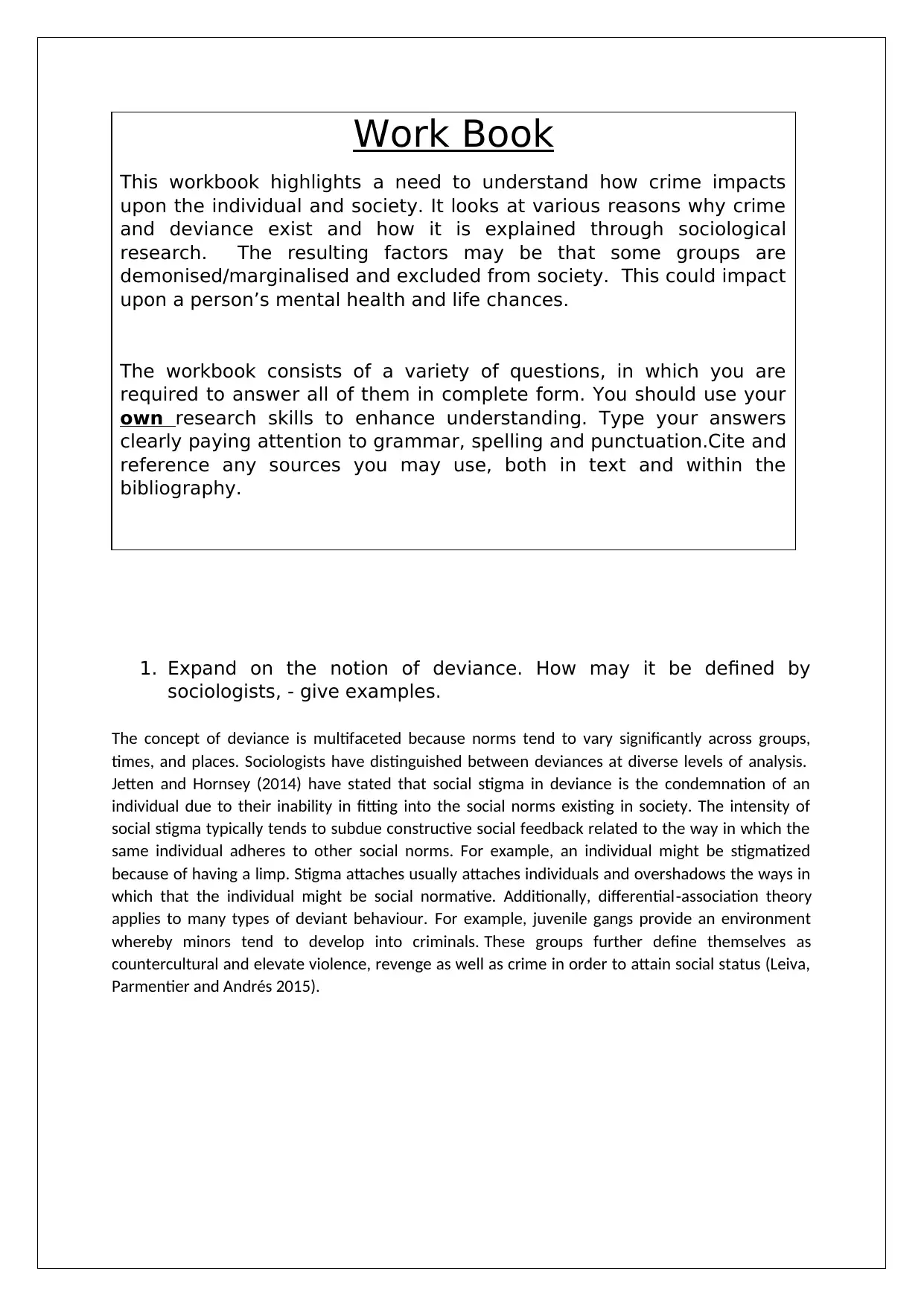
Work Book
This workbook highlights a need to understand how crime impacts
upon the individual and society. It looks at various reasons why crime
and deviance exist and how it is explained through sociological
research. The resulting factors may be that some groups are
demonised/marginalised and excluded from society. This could impact
upon a person’s mental health and life chances.
The workbook consists of a variety of questions, in which you are
required to answer all of them in complete form. You should use your
own research skills to enhance understanding. Type your answers
clearly paying attention to grammar, spelling and punctuation.Cite and
reference any sources you may use, both in text and within the
bibliography.
1. Expand on the notion of deviance. How may it be defined by
sociologists, - give examples.
The concept of deviance is multifaceted because norms tend to vary significantly across groups,
times, and places. Sociologists have distinguished between deviances at diverse levels of analysis.
Jetten and Hornsey (2014) have stated that social stigma in deviance is the condemnation of an
individual due to their inability in fitting into the social norms existing in society. The intensity of
social stigma typically tends to subdue constructive social feedback related to the way in which the
same individual adheres to other social norms. For example, an individual might be stigmatized
because of having a limp. Stigma attaches usually attaches individuals and overshadows the ways in
which that the individual might be social normative. Additionally, differential‐association theory
applies to many types of deviant behaviour. For example, juvenile gangs provide an environment
whereby minors tend to develop into criminals. These groups further define themselves as
countercultural and elevate violence, revenge as well as crime in order to attain social status (Leiva,
Parmentier and Andrés 2015).
This workbook highlights a need to understand how crime impacts
upon the individual and society. It looks at various reasons why crime
and deviance exist and how it is explained through sociological
research. The resulting factors may be that some groups are
demonised/marginalised and excluded from society. This could impact
upon a person’s mental health and life chances.
The workbook consists of a variety of questions, in which you are
required to answer all of them in complete form. You should use your
own research skills to enhance understanding. Type your answers
clearly paying attention to grammar, spelling and punctuation.Cite and
reference any sources you may use, both in text and within the
bibliography.
1. Expand on the notion of deviance. How may it be defined by
sociologists, - give examples.
The concept of deviance is multifaceted because norms tend to vary significantly across groups,
times, and places. Sociologists have distinguished between deviances at diverse levels of analysis.
Jetten and Hornsey (2014) have stated that social stigma in deviance is the condemnation of an
individual due to their inability in fitting into the social norms existing in society. The intensity of
social stigma typically tends to subdue constructive social feedback related to the way in which the
same individual adheres to other social norms. For example, an individual might be stigmatized
because of having a limp. Stigma attaches usually attaches individuals and overshadows the ways in
which that the individual might be social normative. Additionally, differential‐association theory
applies to many types of deviant behaviour. For example, juvenile gangs provide an environment
whereby minors tend to develop into criminals. These groups further define themselves as
countercultural and elevate violence, revenge as well as crime in order to attain social status (Leiva,
Parmentier and Andrés 2015).

2. Define crime giving examples. Add depth and breadth to your work
by demonstrating independent research by citing
laws/policies/guidelines which are in force to prevent/manage such
behaviours.
Belknap (2014) has provided a typology in order to categorize deviant acts in
relation to their perceived harmfulness the extent of consensus related to the norms which
have been violated in addition to the criticality of the response towards them. The most
severe acts of crime are regarded as consensus crimes where why there is near unanimous
public agreement. Criminal acts such as murder and sexual violence are typically considered
as morally intolerable detrimental and subject to stringent penalties. Meanwhile according
to Jetten and Hornsey (2014), conflict crimes are regarded as acts like prostitution or
smoking marijuana which may be illegal but comprises a substantial public disagreement is
related to its severity. Lastly there can be identified social deviations related to criminal acts
such as passing abusing comments arising from mental illness and addiction which are not
perceived as illegal but typically reflect certain degree of severity.
Foucault has described discipline as a key mechanism in forming a normalizing
society. The establishment of norms and significant development of disciplinary procedures
in order to correct deviance and crimes from norms have developed into an increasingly
fundamental determinant to the organisation as well as operation of institution from the
19th century. Lane (2017) has noted that to the extent that sociological norms have been
used in order to govern the lives of individuals' more than laws and legislations society can
be said to be regulated through normalization along with disciplinary procedures. However
the use of formal legislations quotes and law enforcement agencies have its significance
when there is an infringement in law whereby disciplinary strategies facilitate the
continuous and engineering social control of and extending range of activities functioning in
the lives of individuals to surveillance, observation and normalization (Belknap 2014).
3. Analyse the concept of blue collar crime – give examples especially
with regards to recent trends, include statistics to support your
answer. How do sociologists explain this phenomenon? Are there
environmental factors associated with such behaviour?
Blue-collar crime is considered as any crime committed by an individual from a lower social class in
opposition to White-Collar Crime in relation to crime committed by individuals of a higher social
class. Reports of Munro (2014) have revealed that law enforcement agencies in the U.K reported a
decline of 5.4% in the number of violent crimes brought to their attention for the initial 6 months of
2013. However, the issue remains that several blue collar crimes have not been accounted to law
enforcement agencies. Thus, has led one of the all aggressive crime and around 40% of property
crime to remain unreported annually (Leiva, Parmentier and Andrés 2015). Majority of blue collar
workers have been paid a low hourly wage, though the income primarily varies greatly relying upon
the specific occupation and the worker's level of skill. For example, crimes against the individual,
crimes against property along with several forms of victimless crime such as prostitution tend to be
classified as blue-collar crime. Blue-collar crimes have been those which tend to cause an abrupt and
highly visible injury to society, so have been typically punished much more rapidly and severely than
white-collar crime. Furthermore, citizens of lower social class cannot generally pay for high-quality
by demonstrating independent research by citing
laws/policies/guidelines which are in force to prevent/manage such
behaviours.
Belknap (2014) has provided a typology in order to categorize deviant acts in
relation to their perceived harmfulness the extent of consensus related to the norms which
have been violated in addition to the criticality of the response towards them. The most
severe acts of crime are regarded as consensus crimes where why there is near unanimous
public agreement. Criminal acts such as murder and sexual violence are typically considered
as morally intolerable detrimental and subject to stringent penalties. Meanwhile according
to Jetten and Hornsey (2014), conflict crimes are regarded as acts like prostitution or
smoking marijuana which may be illegal but comprises a substantial public disagreement is
related to its severity. Lastly there can be identified social deviations related to criminal acts
such as passing abusing comments arising from mental illness and addiction which are not
perceived as illegal but typically reflect certain degree of severity.
Foucault has described discipline as a key mechanism in forming a normalizing
society. The establishment of norms and significant development of disciplinary procedures
in order to correct deviance and crimes from norms have developed into an increasingly
fundamental determinant to the organisation as well as operation of institution from the
19th century. Lane (2017) has noted that to the extent that sociological norms have been
used in order to govern the lives of individuals' more than laws and legislations society can
be said to be regulated through normalization along with disciplinary procedures. However
the use of formal legislations quotes and law enforcement agencies have its significance
when there is an infringement in law whereby disciplinary strategies facilitate the
continuous and engineering social control of and extending range of activities functioning in
the lives of individuals to surveillance, observation and normalization (Belknap 2014).
3. Analyse the concept of blue collar crime – give examples especially
with regards to recent trends, include statistics to support your
answer. How do sociologists explain this phenomenon? Are there
environmental factors associated with such behaviour?
Blue-collar crime is considered as any crime committed by an individual from a lower social class in
opposition to White-Collar Crime in relation to crime committed by individuals of a higher social
class. Reports of Munro (2014) have revealed that law enforcement agencies in the U.K reported a
decline of 5.4% in the number of violent crimes brought to their attention for the initial 6 months of
2013. However, the issue remains that several blue collar crimes have not been accounted to law
enforcement agencies. Thus, has led one of the all aggressive crime and around 40% of property
crime to remain unreported annually (Leiva, Parmentier and Andrés 2015). Majority of blue collar
workers have been paid a low hourly wage, though the income primarily varies greatly relying upon
the specific occupation and the worker's level of skill. For example, crimes against the individual,
crimes against property along with several forms of victimless crime such as prostitution tend to be
classified as blue-collar crime. Blue-collar crimes have been those which tend to cause an abrupt and
highly visible injury to society, so have been typically punished much more rapidly and severely than
white-collar crime. Furthermore, citizens of lower social class cannot generally pay for high-quality
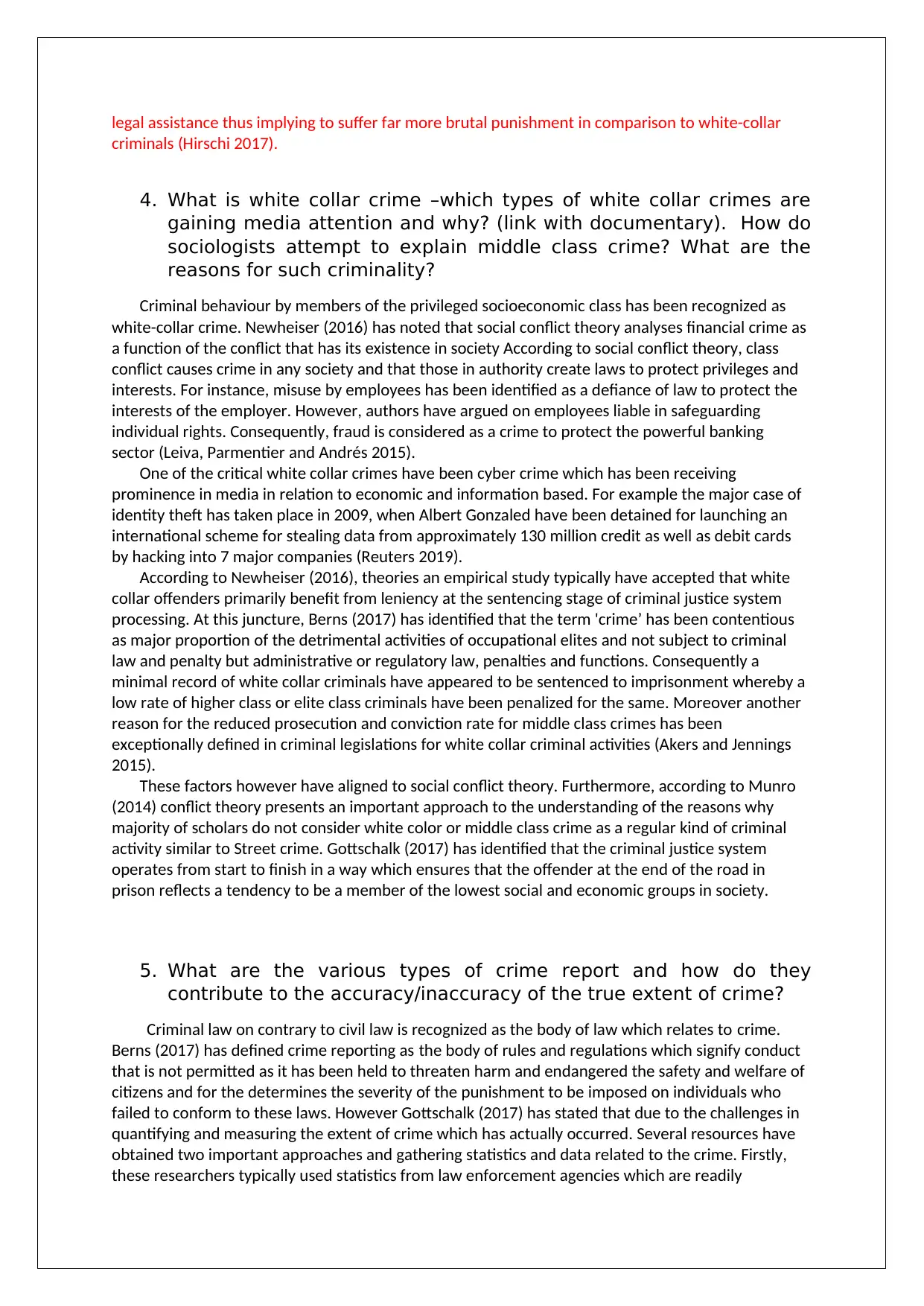
legal assistance thus implying to suffer far more brutal punishment in comparison to white-collar
criminals (Hirschi 2017).
4. What is white collar crime –which types of white collar crimes are
gaining media attention and why? (link with documentary). How do
sociologists attempt to explain middle class crime? What are the
reasons for such criminality?
Criminal behaviour by members of the privileged socioeconomic class has been recognized as
white-collar crime. Newheiser (2016) has noted that social conflict theory analyses financial crime as
a function of the conflict that has its existence in society According to social conflict theory, class
conflict causes crime in any society and that those in authority create laws to protect privileges and
interests. For instance, misuse by employees has been identified as a defiance of law to protect the
interests of the employer. However, authors have argued on employees liable in safeguarding
individual rights. Consequently, fraud is considered as a crime to protect the powerful banking
sector (Leiva, Parmentier and Andrés 2015).
One of the critical white collar crimes have been cyber crime which has been receiving
prominence in media in relation to economic and information based. For example the major case of
identity theft has taken place in 2009, when Albert Gonzaled have been detained for launching an
international scheme for stealing data from approximately 130 million credit as well as debit cards
by hacking into 7 major companies (Reuters 2019).
According to Newheiser (2016), theories an empirical study typically have accepted that white
collar offenders primarily benefit from leniency at the sentencing stage of criminal justice system
processing. At this juncture, Berns (2017) has identified that the term 'crime’ has been contentious
as major proportion of the detrimental activities of occupational elites and not subject to criminal
law and penalty but administrative or regulatory law, penalties and functions. Consequently a
minimal record of white collar criminals have appeared to be sentenced to imprisonment whereby a
low rate of higher class or elite class criminals have been penalized for the same. Moreover another
reason for the reduced prosecution and conviction rate for middle class crimes has been
exceptionally defined in criminal legislations for white collar criminal activities (Akers and Jennings
2015).
These factors however have aligned to social conflict theory. Furthermore, according to Munro
(2014) conflict theory presents an important approach to the understanding of the reasons why
majority of scholars do not consider white color or middle class crime as a regular kind of criminal
activity similar to Street crime. Gottschalk (2017) has identified that the criminal justice system
operates from start to finish in a way which ensures that the offender at the end of the road in
prison reflects a tendency to be a member of the lowest social and economic groups in society.
5. What are the various types of crime report and how do they
contribute to the accuracy/inaccuracy of the true extent of crime?
Criminal law on contrary to civil law is recognized as the body of law which relates to crime.
Berns (2017) has defined crime reporting as the body of rules and regulations which signify conduct
that is not permitted as it has been held to threaten harm and endangered the safety and welfare of
citizens and for the determines the severity of the punishment to be imposed on individuals who
failed to conform to these laws. However Gottschalk (2017) has stated that due to the challenges in
quantifying and measuring the extent of crime which has actually occurred. Several resources have
obtained two important approaches and gathering statistics and data related to the crime. Firstly,
these researchers typically used statistics from law enforcement agencies which are readily
criminals (Hirschi 2017).
4. What is white collar crime –which types of white collar crimes are
gaining media attention and why? (link with documentary). How do
sociologists attempt to explain middle class crime? What are the
reasons for such criminality?
Criminal behaviour by members of the privileged socioeconomic class has been recognized as
white-collar crime. Newheiser (2016) has noted that social conflict theory analyses financial crime as
a function of the conflict that has its existence in society According to social conflict theory, class
conflict causes crime in any society and that those in authority create laws to protect privileges and
interests. For instance, misuse by employees has been identified as a defiance of law to protect the
interests of the employer. However, authors have argued on employees liable in safeguarding
individual rights. Consequently, fraud is considered as a crime to protect the powerful banking
sector (Leiva, Parmentier and Andrés 2015).
One of the critical white collar crimes have been cyber crime which has been receiving
prominence in media in relation to economic and information based. For example the major case of
identity theft has taken place in 2009, when Albert Gonzaled have been detained for launching an
international scheme for stealing data from approximately 130 million credit as well as debit cards
by hacking into 7 major companies (Reuters 2019).
According to Newheiser (2016), theories an empirical study typically have accepted that white
collar offenders primarily benefit from leniency at the sentencing stage of criminal justice system
processing. At this juncture, Berns (2017) has identified that the term 'crime’ has been contentious
as major proportion of the detrimental activities of occupational elites and not subject to criminal
law and penalty but administrative or regulatory law, penalties and functions. Consequently a
minimal record of white collar criminals have appeared to be sentenced to imprisonment whereby a
low rate of higher class or elite class criminals have been penalized for the same. Moreover another
reason for the reduced prosecution and conviction rate for middle class crimes has been
exceptionally defined in criminal legislations for white collar criminal activities (Akers and Jennings
2015).
These factors however have aligned to social conflict theory. Furthermore, according to Munro
(2014) conflict theory presents an important approach to the understanding of the reasons why
majority of scholars do not consider white color or middle class crime as a regular kind of criminal
activity similar to Street crime. Gottschalk (2017) has identified that the criminal justice system
operates from start to finish in a way which ensures that the offender at the end of the road in
prison reflects a tendency to be a member of the lowest social and economic groups in society.
5. What are the various types of crime report and how do they
contribute to the accuracy/inaccuracy of the true extent of crime?
Criminal law on contrary to civil law is recognized as the body of law which relates to crime.
Berns (2017) has defined crime reporting as the body of rules and regulations which signify conduct
that is not permitted as it has been held to threaten harm and endangered the safety and welfare of
citizens and for the determines the severity of the punishment to be imposed on individuals who
failed to conform to these laws. However Gottschalk (2017) has stated that due to the challenges in
quantifying and measuring the extent of crime which has actually occurred. Several resources have
obtained two important approaches and gathering statistics and data related to the crime. Firstly,
these researchers typically used statistics from law enforcement agencies which are readily
Secure Best Marks with AI Grader
Need help grading? Try our AI Grader for instant feedback on your assignments.
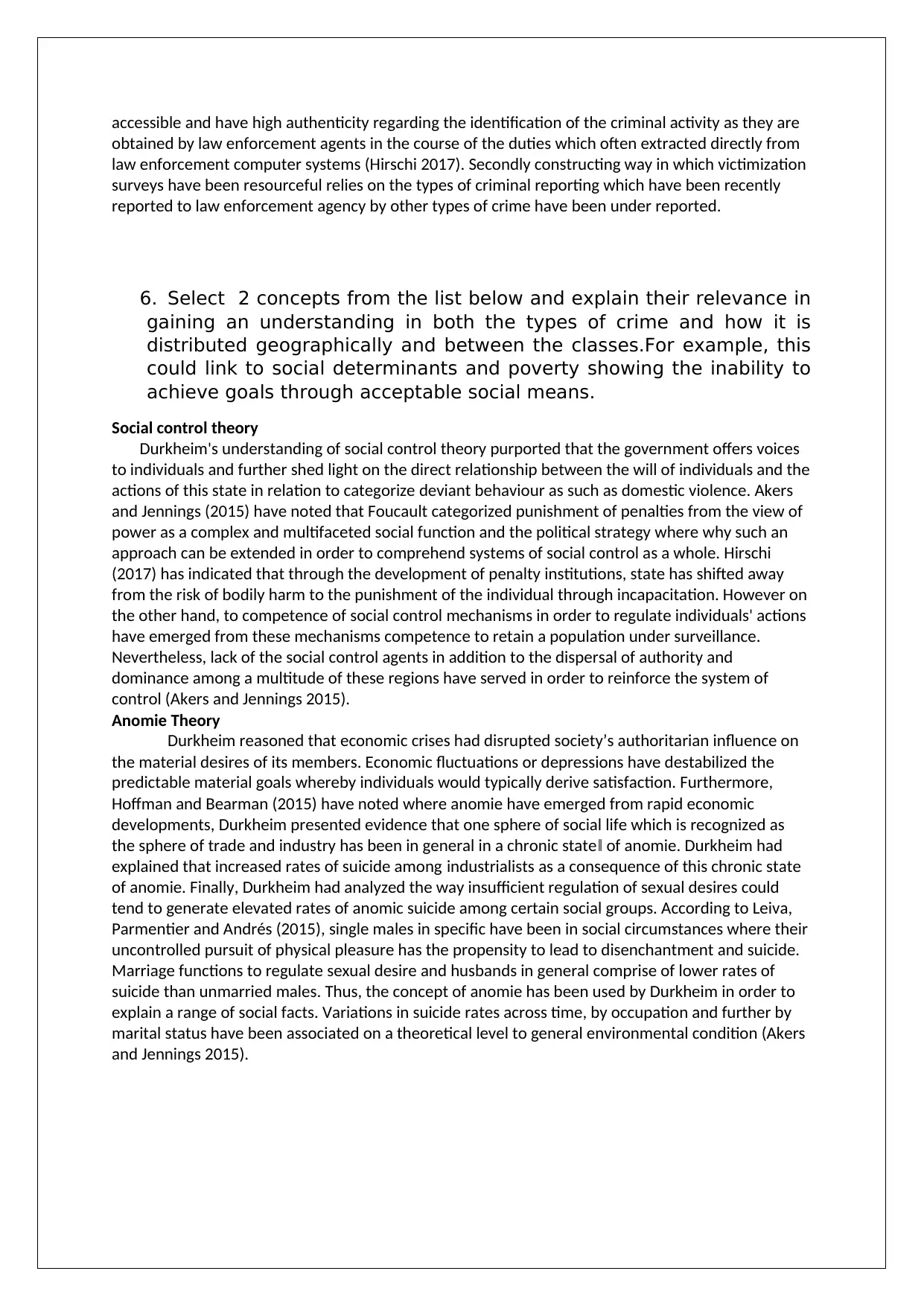
accessible and have high authenticity regarding the identification of the criminal activity as they are
obtained by law enforcement agents in the course of the duties which often extracted directly from
law enforcement computer systems (Hirschi 2017). Secondly constructing way in which victimization
surveys have been resourceful relies on the types of criminal reporting which have been recently
reported to law enforcement agency by other types of crime have been under reported.
6. Select 2 concepts from the list below and explain their relevance in
gaining an understanding in both the types of crime and how it is
distributed geographically and between the classes.For example, this
could link to social determinants and poverty showing the inability to
achieve goals through acceptable social means.
Social control theory
Durkheim's understanding of social control theory purported that the government offers voices
to individuals and further shed light on the direct relationship between the will of individuals and the
actions of this state in relation to categorize deviant behaviour as such as domestic violence. Akers
and Jennings (2015) have noted that Foucault categorized punishment of penalties from the view of
power as a complex and multifaceted social function and the political strategy where why such an
approach can be extended in order to comprehend systems of social control as a whole. Hirschi
(2017) has indicated that through the development of penalty institutions, state has shifted away
from the risk of bodily harm to the punishment of the individual through incapacitation. However on
the other hand, to competence of social control mechanisms in order to regulate individuals' actions
have emerged from these mechanisms competence to retain a population under surveillance.
Nevertheless, lack of the social control agents in addition to the dispersal of authority and
dominance among a multitude of these regions have served in order to reinforce the system of
control (Akers and Jennings 2015).
Anomie Theory
Durkheim reasoned that economic crises had disrupted society’s authoritarian influence on
the material desires of its members. Economic fluctuations or depressions have destabilized the
predictable material goals whereby individuals would typically derive satisfaction. Furthermore,
Hoffman and Bearman (2015) have noted where anomie have emerged from rapid economic
developments, Durkheim presented evidence that one sphere of social life which is recognized as
the sphere of trade and industry has been in general in a chronic state‖ of anomie. Durkheim had
explained that increased rates of suicide among industrialists as a consequence of this chronic state
of anomie. Finally, Durkheim had analyzed the way insufficient regulation of sexual desires could
tend to generate elevated rates of anomic suicide among certain social groups. According to Leiva,
Parmentier and Andrés (2015), single males in specific have been in social circumstances where their
uncontrolled pursuit of physical pleasure has the propensity to lead to disenchantment and suicide.
Marriage functions to regulate sexual desire and husbands in general comprise of lower rates of
suicide than unmarried males. Thus, the concept of anomie has been used by Durkheim in order to
explain a range of social facts. Variations in suicide rates across time, by occupation and further by
marital status have been associated on a theoretical level to general environmental condition (Akers
and Jennings 2015).
obtained by law enforcement agents in the course of the duties which often extracted directly from
law enforcement computer systems (Hirschi 2017). Secondly constructing way in which victimization
surveys have been resourceful relies on the types of criminal reporting which have been recently
reported to law enforcement agency by other types of crime have been under reported.
6. Select 2 concepts from the list below and explain their relevance in
gaining an understanding in both the types of crime and how it is
distributed geographically and between the classes.For example, this
could link to social determinants and poverty showing the inability to
achieve goals through acceptable social means.
Social control theory
Durkheim's understanding of social control theory purported that the government offers voices
to individuals and further shed light on the direct relationship between the will of individuals and the
actions of this state in relation to categorize deviant behaviour as such as domestic violence. Akers
and Jennings (2015) have noted that Foucault categorized punishment of penalties from the view of
power as a complex and multifaceted social function and the political strategy where why such an
approach can be extended in order to comprehend systems of social control as a whole. Hirschi
(2017) has indicated that through the development of penalty institutions, state has shifted away
from the risk of bodily harm to the punishment of the individual through incapacitation. However on
the other hand, to competence of social control mechanisms in order to regulate individuals' actions
have emerged from these mechanisms competence to retain a population under surveillance.
Nevertheless, lack of the social control agents in addition to the dispersal of authority and
dominance among a multitude of these regions have served in order to reinforce the system of
control (Akers and Jennings 2015).
Anomie Theory
Durkheim reasoned that economic crises had disrupted society’s authoritarian influence on
the material desires of its members. Economic fluctuations or depressions have destabilized the
predictable material goals whereby individuals would typically derive satisfaction. Furthermore,
Hoffman and Bearman (2015) have noted where anomie have emerged from rapid economic
developments, Durkheim presented evidence that one sphere of social life which is recognized as
the sphere of trade and industry has been in general in a chronic state‖ of anomie. Durkheim had
explained that increased rates of suicide among industrialists as a consequence of this chronic state
of anomie. Finally, Durkheim had analyzed the way insufficient regulation of sexual desires could
tend to generate elevated rates of anomic suicide among certain social groups. According to Leiva,
Parmentier and Andrés (2015), single males in specific have been in social circumstances where their
uncontrolled pursuit of physical pleasure has the propensity to lead to disenchantment and suicide.
Marriage functions to regulate sexual desire and husbands in general comprise of lower rates of
suicide than unmarried males. Thus, the concept of anomie has been used by Durkheim in order to
explain a range of social facts. Variations in suicide rates across time, by occupation and further by
marital status have been associated on a theoretical level to general environmental condition (Akers
and Jennings 2015).
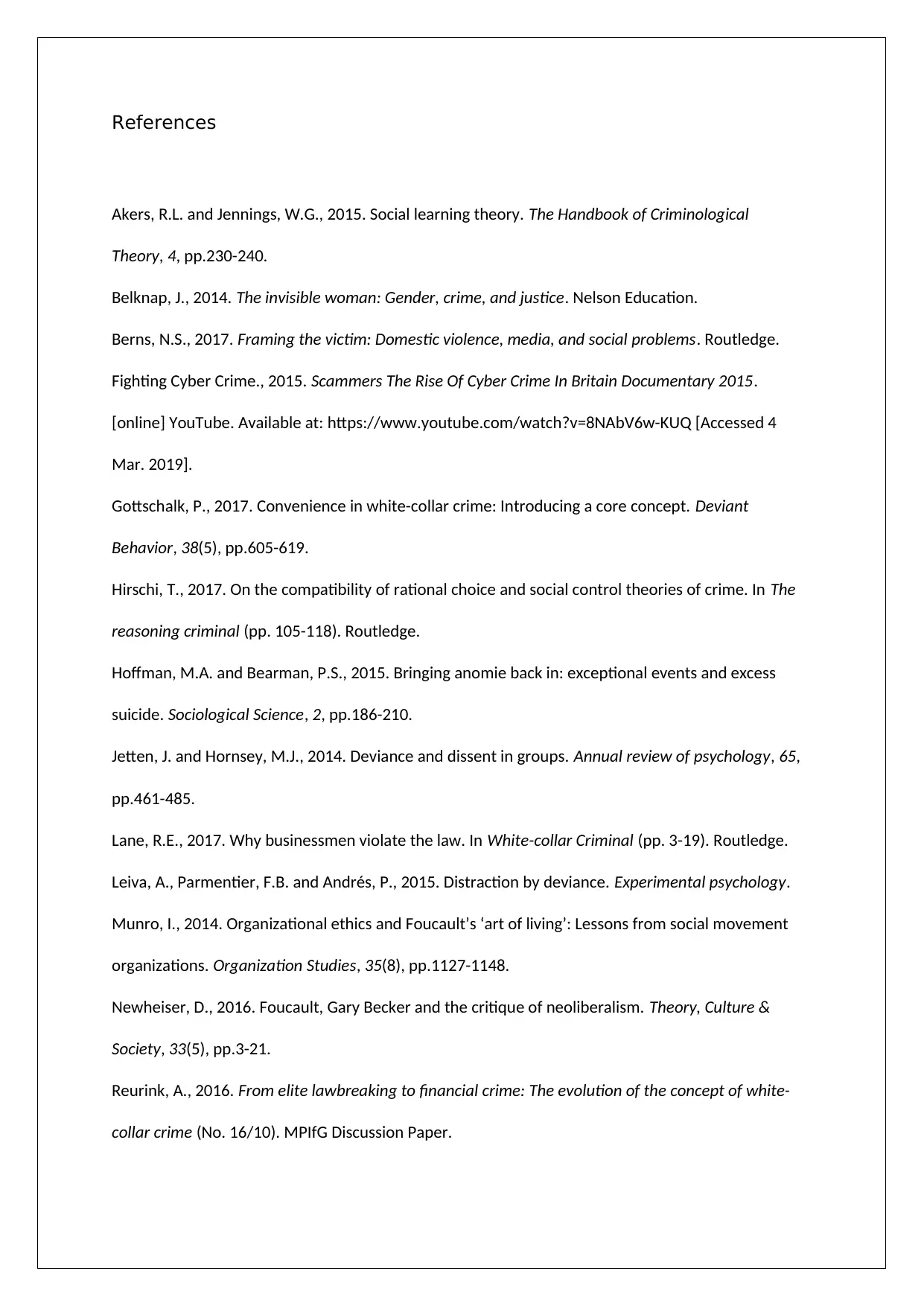
References
Akers, R.L. and Jennings, W.G., 2015. Social learning theory. The Handbook of Criminological
Theory, 4, pp.230-240.
Belknap, J., 2014. The invisible woman: Gender, crime, and justice. Nelson Education.
Berns, N.S., 2017. Framing the victim: Domestic violence, media, and social problems. Routledge.
Fighting Cyber Crime., 2015. Scammers The Rise Of Cyber Crime In Britain Documentary 2015.
[online] YouTube. Available at: https://www.youtube.com/watch?v=8NAbV6w-KUQ [Accessed 4
Mar. 2019].
Gottschalk, P., 2017. Convenience in white-collar crime: Introducing a core concept. Deviant
Behavior, 38(5), pp.605-619.
Hirschi, T., 2017. On the compatibility of rational choice and social control theories of crime. In The
reasoning criminal (pp. 105-118). Routledge.
Hoffman, M.A. and Bearman, P.S., 2015. Bringing anomie back in: exceptional events and excess
suicide. Sociological Science, 2, pp.186-210.
Jetten, J. and Hornsey, M.J., 2014. Deviance and dissent in groups. Annual review of psychology, 65,
pp.461-485.
Lane, R.E., 2017. Why businessmen violate the law. In White-collar Criminal (pp. 3-19). Routledge.
Leiva, A., Parmentier, F.B. and Andrés, P., 2015. Distraction by deviance. Experimental psychology.
Munro, I., 2014. Organizational ethics and Foucault’s ‘art of living’: Lessons from social movement
organizations. Organization Studies, 35(8), pp.1127-1148.
Newheiser, D., 2016. Foucault, Gary Becker and the critique of neoliberalism. Theory, Culture &
Society, 33(5), pp.3-21.
Reurink, A., 2016. From elite lawbreaking to financial crime: The evolution of the concept of white-
collar crime (No. 16/10). MPIfG Discussion Paper.
Akers, R.L. and Jennings, W.G., 2015. Social learning theory. The Handbook of Criminological
Theory, 4, pp.230-240.
Belknap, J., 2014. The invisible woman: Gender, crime, and justice. Nelson Education.
Berns, N.S., 2017. Framing the victim: Domestic violence, media, and social problems. Routledge.
Fighting Cyber Crime., 2015. Scammers The Rise Of Cyber Crime In Britain Documentary 2015.
[online] YouTube. Available at: https://www.youtube.com/watch?v=8NAbV6w-KUQ [Accessed 4
Mar. 2019].
Gottschalk, P., 2017. Convenience in white-collar crime: Introducing a core concept. Deviant
Behavior, 38(5), pp.605-619.
Hirschi, T., 2017. On the compatibility of rational choice and social control theories of crime. In The
reasoning criminal (pp. 105-118). Routledge.
Hoffman, M.A. and Bearman, P.S., 2015. Bringing anomie back in: exceptional events and excess
suicide. Sociological Science, 2, pp.186-210.
Jetten, J. and Hornsey, M.J., 2014. Deviance and dissent in groups. Annual review of psychology, 65,
pp.461-485.
Lane, R.E., 2017. Why businessmen violate the law. In White-collar Criminal (pp. 3-19). Routledge.
Leiva, A., Parmentier, F.B. and Andrés, P., 2015. Distraction by deviance. Experimental psychology.
Munro, I., 2014. Organizational ethics and Foucault’s ‘art of living’: Lessons from social movement
organizations. Organization Studies, 35(8), pp.1127-1148.
Newheiser, D., 2016. Foucault, Gary Becker and the critique of neoliberalism. Theory, Culture &
Society, 33(5), pp.3-21.
Reurink, A., 2016. From elite lawbreaking to financial crime: The evolution of the concept of white-
collar crime (No. 16/10). MPIfG Discussion Paper.
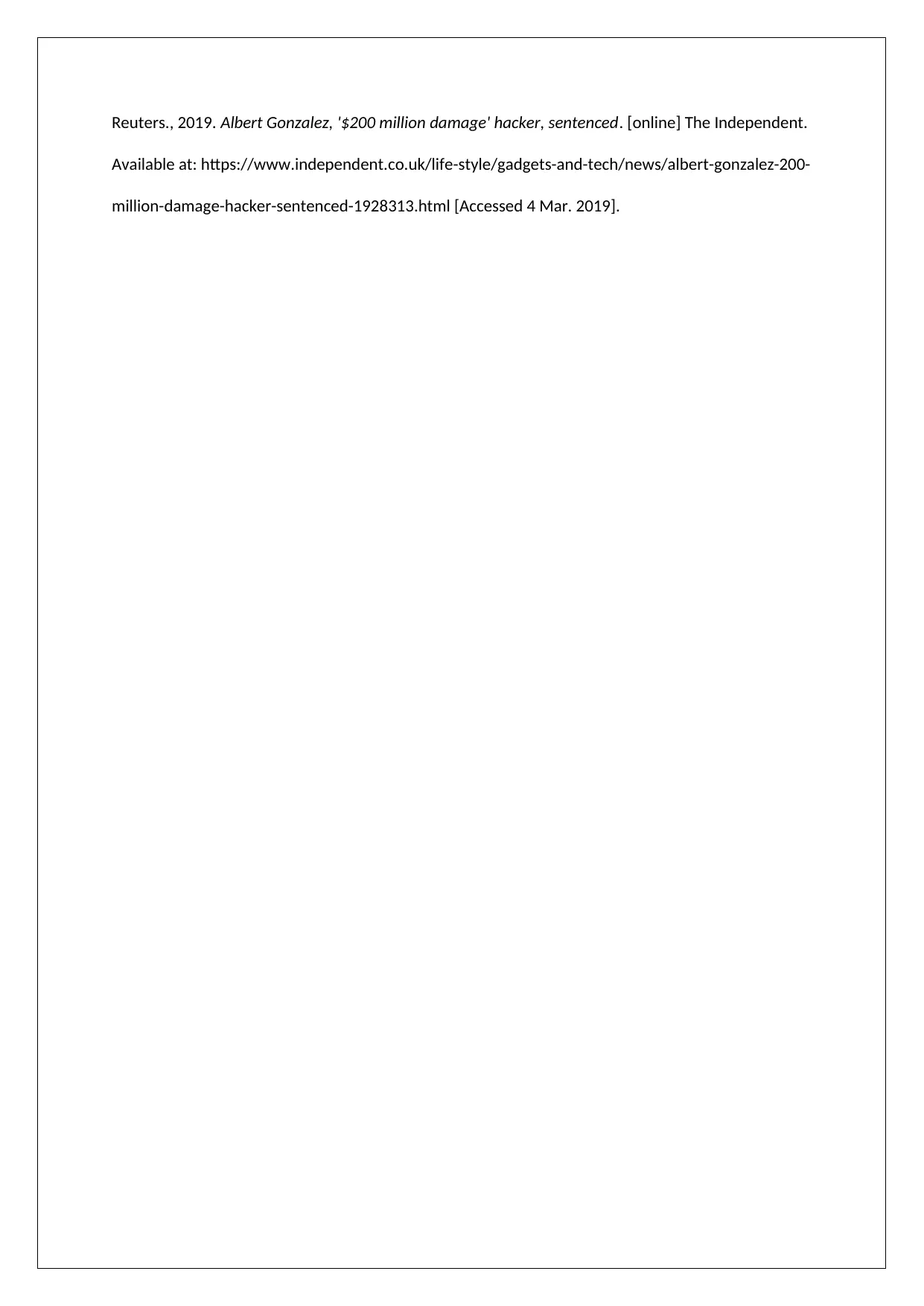
Reuters., 2019. Albert Gonzalez, '$200 million damage' hacker, sentenced. [online] The Independent.
Available at: https://www.independent.co.uk/life-style/gadgets-and-tech/news/albert-gonzalez-200-
million-damage-hacker-sentenced-1928313.html [Accessed 4 Mar. 2019].
Available at: https://www.independent.co.uk/life-style/gadgets-and-tech/news/albert-gonzalez-200-
million-damage-hacker-sentenced-1928313.html [Accessed 4 Mar. 2019].
1 out of 7
Related Documents
Your All-in-One AI-Powered Toolkit for Academic Success.
+13062052269
info@desklib.com
Available 24*7 on WhatsApp / Email
![[object Object]](/_next/static/media/star-bottom.7253800d.svg)
Unlock your academic potential
© 2024 | Zucol Services PVT LTD | All rights reserved.



